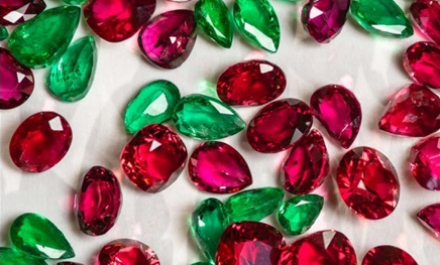Dacques Nini, GIA GG, PG, JDT, FCGmA, has years of adventures in some of the most famous and exotic sources of diamonds and coloured gemstones. He has lived in Canada, South Africa and Brazil as a gemstone trader. Working as a field gemmologist, Nini visits gemstone countries such as Brazil, Colombia, Myanmar, India, Thailand and Sri Lanka. He has likewise visited some of the famed diamond mines in Botswana, Namibia, Lesotho and South Africa.
Dacques Nini, GIA GG, PG, JDT, FCGmA, has years of adventures in some of the most famous and exotic sources of diamonds and coloured gemstones. He has lived in Canada, South Africa and Brazil as a gemstone trader. Working as a field gemmologist, Nini visits gemstone countries such as Brazil, Colombia, Myanmar, India, Thailand and Sri Lanka. He has likewise visited some of the famed diamond mines in Botswana, Namibia, Lesotho and South Africa.
An international coloured gemstone dealer with a passion for field gemmology and fine jewellery design, Nini’s 18-year career spans collaborations with American fashion designers, gemstone merchants and major diamantaires worldwide. He is a fellow of the Canadian Gemmological Association (CGA), a member of the World Jewellery Federation (CIBJO), the International Colored Gemstone Association (ICA), the American Gem Trade Association (AGTA) and the GIA Alumni Association, serving as chairman of the Houston chapter.
Nini joined a team of 40 gemmologists and traders at an expedition in Mogok in December 2018 – his third trip to the Ruby Land. The author had a special interview with him on his Mogok trip.
You said that Mogok is the second most difficult place to visit after Kashmir. Why?
From the pages of historic writings to 21st-century gemmological literature, the lore surrounding the origins of the best-of-the-best gemstones has fascinated gem lovers. I am no exception. Two of my favourite colours are the vivid reds and deep blues that are embodied in ruby, sapphire and spinel, which come from two mythic, yet hard to access, regions.
The prized producers of the world’s finest gemstones – Kashmir and Mogok – are steeped in mystery. Because of its altitude, location and religious wars, Kashmir is one of the most difficult regions on the planet to access. Mogok meanwhile has a history of harsh controlling powers, right up to modern times, that have isolated Myanmar, and hence Mogok, from the rest of the world.
From a purely physical point of view, Kashmir is at an altitude of 14,000 to 17,000 feet, and Mogok is about 6,000 to 7,000 feet. These very high altitudes compound the difficulty of access and add to the challenges of mining there, making Kashmir the most difficult and Mogok the second most difficult to work in and/or visit. Each area is under severe regulation and permission to visit is very seldom granted to foreigners. Both Kashmir and Mogok also present the danger of physical harm to visitors, including kidnappings, killings and robbery, among others.
Going to these places often requires very long flights of at least 16 hours or more. Is this a problem for you?
I guess the best answer to that is “what about people who sit at a desk eight hours a day, every day?” It is true that plane flights can be long, even taking sometimes 40 hours to arrive at the final destination but the journey is always worth it.
I also am gratified that I am able to share my adventures through social media with people around the globe. I can’t help but notice an insatiable travel wanderlust that many millennials (as well as others) have, based on the comments I receive from followers of my Instagram page – Dacques® Rare Beautiful Jewels.
You have gone to Mogok three times. Why is this place so special to you?
Visiting Mogok once is a dream come true for any gemmologist. A second visit feels like a fantasy. To be lucky enough to make a third trip to Mogok begins to feel like destiny. On my second trip, I asked if there was an orphanage in Mogok and I was introduced to the Lisu children of Grace Haven Orphanage. The Lisu people represent 4 percent of Myanmar’s population, and they share my Christian faith. Yet, I can sincerely say that it would not have mattered to me if they were Kachin State or Buddhist or Muslim kids. Children are children and when you are around them, they remind us that prejudice and intolerance are learned behaviours and not natural to mankind. I love to be around the innocence of a child, and I feel a deep responsibility for orphans and those who are oppressed. While no one person can do everything, each of us can do something. My company Dacques® gives back to the communities where we work, with long-term goals to make a difference.
Is there anything you would like to share about this expedition, explaining why you so love Mogok in particular and Myanmar in general?
As an early riser, I love the morning view over the valley, watching the quiet promenade of the sun through the mist that lingers in the growing light. Sensational! I also appreciate the joy I see in the lives of the local people. I grew up in a small house on the side of a highway with a single mother but I never knew we were a low-income family. There was joy in our home as my mother always made the most of every day. It didn’t matter if dinner was a five-cent can of beans, which had been served from a 20-dollar supply. This same type of zest for life is evident in Mogok and reminds me of my own early experiences. Call it nostalgia, if you want, a respectful nostalgia.
For centuries, three religious faiths have coexisted in these valley regions, along with the government and military. Consequently, I believe the people have a common sense of respect for one another, even though current religious tensions seem to run high in some parts of the country.
It is my fervent hope that I can meet the military leaders of Myanmar in and around Mogok. I want to understand the concerns of both sides of the political situation, from both the military and the civilian government. Myanmar is a beautiful land with beautiful people and the world is changing. We hope that with cooperation, peace and liberty can be closer than most people realise.













